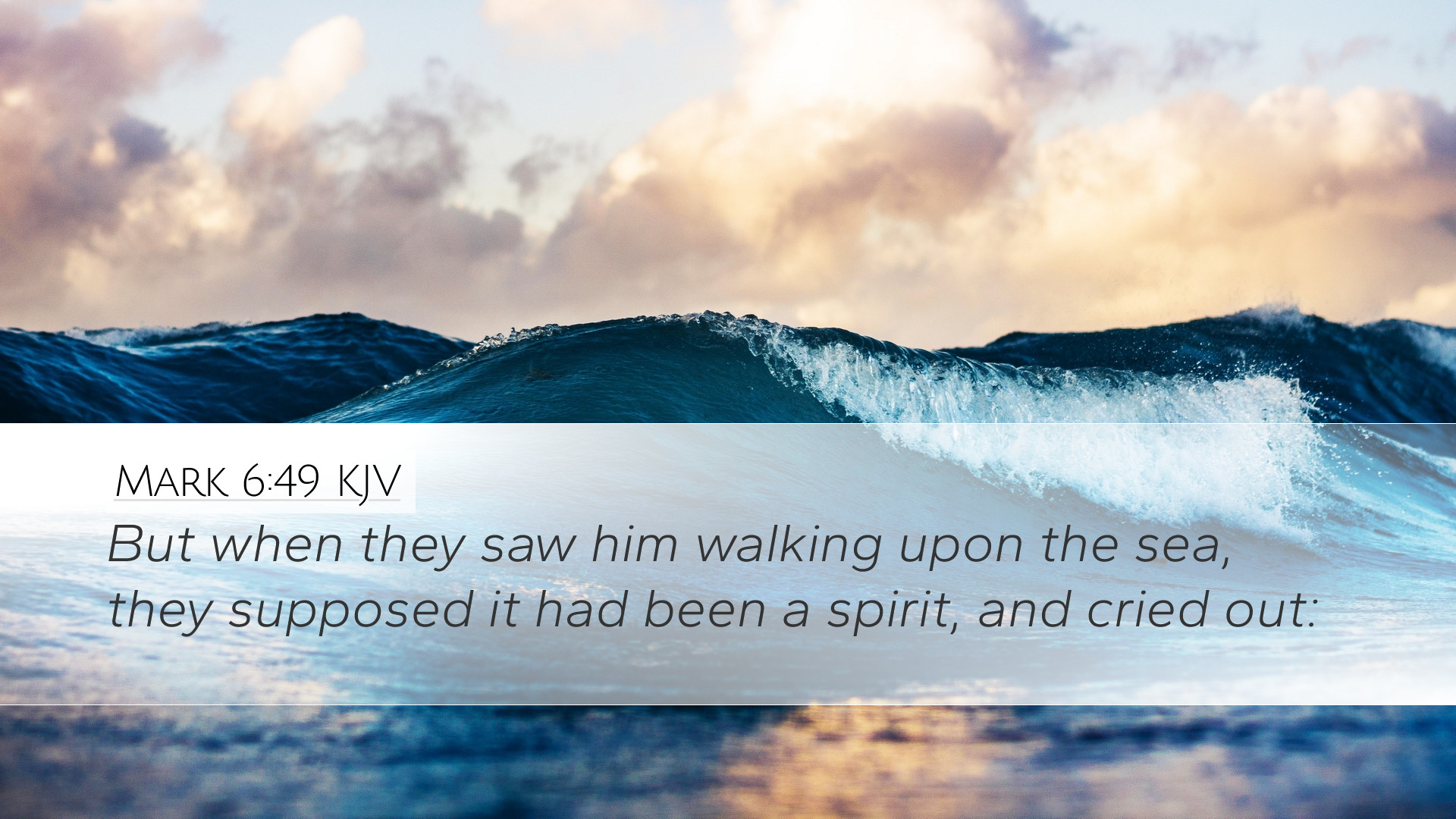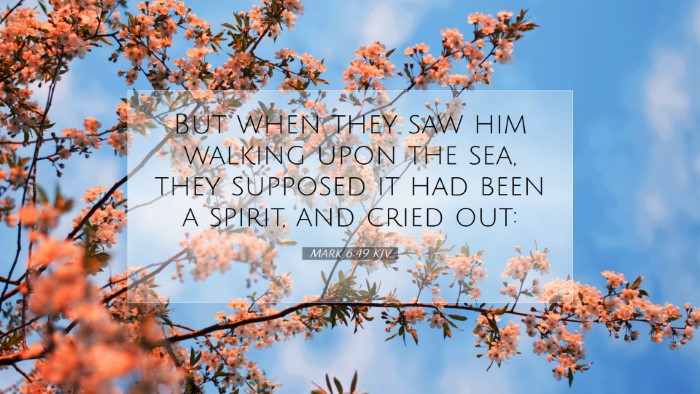Commentary on Mark 6:49
Verse Context: Mark 6:49 reads, "But when they saw him walking on the sea, they thought it was a ghost, and cried out." This verse is set within the narrative of Jesus walking on water, demonstrating both His divine power and His authority over nature.
Introduction
This passage, packed with theological significance, highlights the disciples' fear and misunderstanding of Jesus' identity as He approaches them during a tumultuous time. Several esteemed commentaries illuminate the implications of this moment, helping pastors, students, theologians, and scholars glean profound truths from their insights.
Insights from Matthew Henry
Matthew Henry emphasizes the disciples’ state of mind as they faced the storm. He notes that their fear was not merely of the storm but greatly amplified by the sight of Jesus walking towards them, which they misinterpreted as a ghostly figure. Henry observes that this reflects a common human tendency: in times of distress, one may easily become frightened by appearances rather than recognizing the presence of Christ in their lives.
-
Fear and Misunderstanding: Henry points out that the disciples’ fear illustrates a broader reality of spiritual blindness that often clouds judgment. Even amidst trials, the followers of Christ can misinterpret His actions if they don’t persevere in faith.
-
Divine Assurance: When they cried out, they displayed a lack of recognition of who Jesus really was. This challenge is relatable to believers today; recognizing Christ in the trials of life is crucial for true peace.
Insights from Albert Barnes
Albert Barnes offers a detailed exploration of the supernatural event of Christ walking on water. He underscores that His miraculous ability to walk on water was a clear sign of His divinity, correlated with Old Testament imagery of God’s sovereignty over chaotic waters.
-
Symbolism of Water: Barnes explains that in Jewish thought, water often represented chaos and danger, and by walking over it, Jesus was demonstrating His power over creation itself. This act reinforces the idea that Jesus is not just a prophet but God incarnate.
-
Response to Fear: His commentary also elucidates that the disciples' immediate fear upon seeing Jesus reflects a profound truth: recognizing the divine can evoke fear, particularly when our understanding is clouded by earthly circumstances.
Insights from Adam Clarke
Adam Clarke's commentary dives deep into the cultural and historical context of the passage. He analyzes the term "ghost," explaining that in Jewish culture, there was a prevalent belief in supernatural beings, and the disciples’ cry reveals their immediate inclination to believe in the worst rather than seeing Jesus' saving presence.
-
Cultural Context: Clarke notes that the fear of ghosts was significant in the time of Jesus, and the disciples’ reaction was not uncommon. It illustrates how fear of the unknown can blind individuals to the evidence of God's presence and power.
-
Transformation of Fear to Trust: He emphasizes that this moment serves as an important lesson: fear often precedes revelation. As believers come to understand Christ's true nature, their fears can be transformed into trust and faith.
Theological Themes
The passage invites various theological reflections:
-
Christ’s Divine Authority: The act of walking on water is a manifestation of Jesus' divine authority that surpasses natural laws.
-
Fear and Faith: It highlights the struggle between fear and faith. The disciples' initial fear is a reminder of human frailty in the face of divine activity.
-
Revelation of God’s Presence: The incident calls attention to the need for believers to recognize and respond to the presence of God, even when He appears in unexpected forms.
Practical Applications
For pastors, students, and theologians, the lessons drawn from Mark 6:49 can deeply influence teaching and practice:
-
Encouragement in Turmoil: In the midst of life’s storms, believers must look for Christ, who comes to them even when the situation seems dire.
-
Faith Building: Teaching about the importance of recognizing Jesus amidst fears can bolster faith communities, encouraging believers to trust in God’s sovereignty.
-
Framework for Discipleship: This passage provides a template for understanding discipleship: acknowledging fears while cultivating faith in Christ’s character and presence.
Conclusion
Mark 6:49 serves as a profound reminder of the interplay between fear and faith in the life of the disciples and, by extension, in the life of every believer. The insights provided by Matthew Henry, Albert Barnes, and Adam Clarke enrich our understanding and application of this vital passage. In encouraging believers to recognize Christ’s presence in difficult and terrifying circumstances, this commentary underscores the quiet yet profound truth of His sovereignty and love for His followers.


